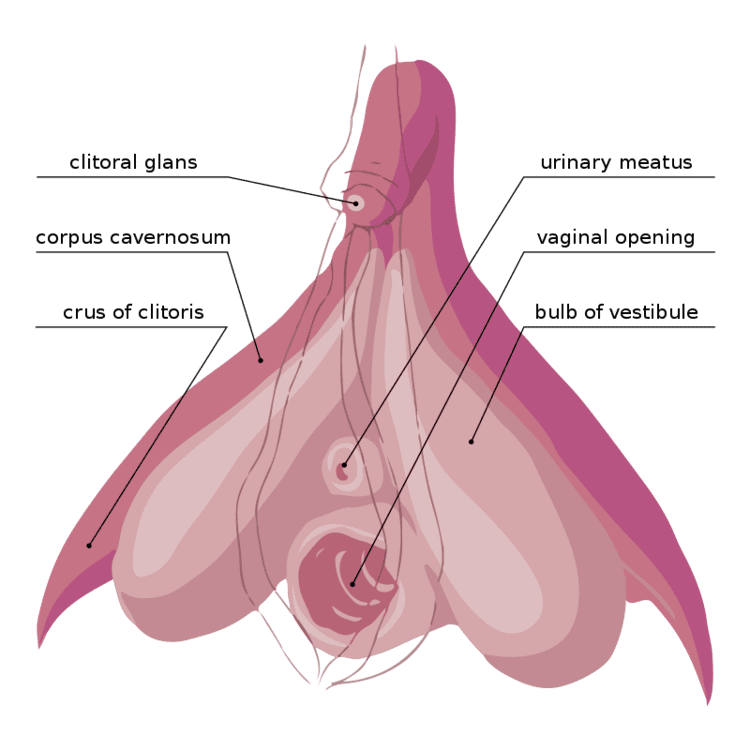 | ||
Similar G spot, Erection, Foreskin | ||
Clitoral erection is a physiological phenomenon where the clitoris becomes enlarged and firm. Clitoral erection is the result of a complex interaction of psychological, neural, vascular and endocrine factors, and is usually, though not exclusively, associated with sexual arousal.
Contents
Cliteracy #3 - Clitoral Erection
Physiology

The clitoris is the homologue of the penis in the female. The part visible on the outside varies in size from a few millimeters to one centimeter and is located hidden in the upper labial fold. Any type of motion can increase blood flow to this organ and this results in increased secretions which lubricate the vagina. There are many ways to stimulate the clitoris.
Clitoral erection occurs when the corpora cavernosa, two expandable erectile structures, become engorged with blood. This may result from any of various physiological stimuli, including sexual arousal. During sexual arousal, arterial blood flow to the clitoris is increased, and trabecular smooth muscle within the clitoris relaxes allowing blood to engorge the erectile tissues. The ischiocavernous and bulbocavernous muscles contract to compress the dorsal vein of the clitoris to stop drainage of the clitoris, trapping the blood. More specifically, the clitoris has 2 adjoining erectile tissues corpus cavernosa (corpus cavernosa clitoridis) that form a main body that connects to the glans clitoridis. There is also a strip of erectile tissue (similar to the placement of the corpus spongiosum in males) running along the ventral surface of the corpus canervosa main body that connects the glans clitoridis to the commissure of the vestibular bulbs. The main body of the corpus canervosa with a ventral erectile tissue strip make up the shaft, which is connected to the glans clitoridis. The tunica albuginea, a fibrous-elastic sheath, surrounds the shaft and glans clitoridis. The tunica albuginea does not surround the bulbs of vestibule. The erectile tissues are composed of endothelium-lined vascular spaces in a trabecular matrix, with the endothelium-lined vascular spaces surrounded by smooth muscle capable of contraction and relaxation.
In the context of sexual arousal, there is an increase in arterial blood flow to the clitoris, which then subdivides further to nourish the erectile tissues. The relaxation of trabecular smooth muscles within these tissues enhances blood circulation, allowing the vascular spaces to fill and causing the erectile tissues to expand until they are completely saturated with blood. The ischiocavernous and bulbocavernous muscles contract, compressing the dorsal vein of the clitoris. This compression of the vein restricts drainage of the erectile structures, trapping the blood. This process stretches the tunica albuginea. As a result, the clitoris becomes tumescent to accommodate the increased intracavernous pressure. The tunica albuginea of the clitoris is made up of one layer making it more elastic than the tunica albuginea of the penis, which is composed of two layers. Erick Janssen (2007) elaborates on this reporting that "the corpora cavernosa of the clitoris are essentially similar to that of the penis except that there is no subalbugineal layer interposed between the tunica albuginea and the erectile tissue. In the penis, this tissue engorges with blood during sexual arousal and becomes compressed against the unyielding tunica, creating penile rigidity --a true erection. The lack of this plexus in the clitoris indicates that while the organ can become tumescent or engorged, it cannot, like the penis become stiffly erect. The clitoris thus does not really become erect with sexual excitement, but engorged." In addition, the tunica albuginea around the glans is thinner than around the shaft in both the clitoris and penis. This gives the glans less firmness relative to the shaft. The extrusion of the glans clitoridis and thinning of the skin enhances sensitivity to physical contact. After a female has orgasmed, the erection usually ends, but this may take time.
